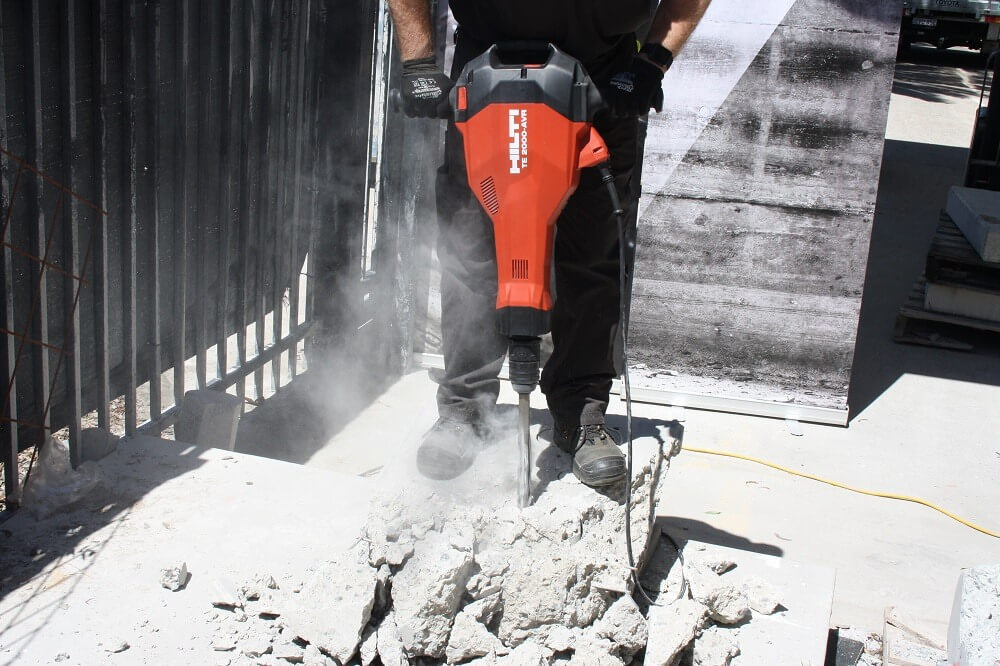Choosing a Jackhammer
Get Inspired
Generally known for their brute destructive power, jackhammers can also be used for quite delicate operations, such as removing mosaic tiles from a bathroom wall or stucco from an interior wall. It’s all about knowing which model you need and which attachment to use.
Those factors depend on the job at hand. Jackhammers can be used on floors, walls, rocks, tiles and lino. A heavy-duty jackhammer can be used to remove a ridge of concrete, while a smaller one can be lifted to access walls and even ceilings.
Although there are petrol-driven, industrial jackhammers, in this article, we’re going to look at the range of electric models for use on DIY projects.
Describing your project
Your local Kennards Hire team will be happy to advise you on which jackhammer to use. Jackhammers are not a “one model fits all” type of machine. To make the right choice, you need to have some details about your project.
If it’s an interior wall, is it load-bearing or a partition wall? Is the wall brick, stone, concrete or some other material? How thick is the wall and what’s its surface area?
If it’s a driveway you want to break up, or a concrete slab, similar details of thickness, length and width are needed.
Once you know these details, you can begin to look at jackhammer sizes, models and attachments.
Jackhammer sizes
Smaller jackhammers are designed to be used horizontally for working on walls. These are what you use if you are removing tiles, plaster or stucco. Like all jackhammers described here, they run on your home power supply.
If you have heavier material to remove, such as brick, you might want to upgrade to a medium demolition hammer. This operates the same way as its lighter cousin, but has more power. It can get the job done faster than the lighter model.
Next comes the heavy duty 30kg demolition hammer. These are not meant to be held up to a wall, but have the classic T-shape jackhammer handles. This is the tool you need for:
- Breaking concrete slabs, footings and paths.
- Removing large tiles and bonded paving.
- Removing and cutting bitumen.
- Removing rock and hard clay.
There are also petrol-driven and hydraulic jackhammers, but it’s unlikely you will need this level of equipment. If you’re unsure, ask your Kennards Hire team.
Hammer drills
You may want to drill through concrete, masonry or brick, but need something more powerful than your regular DIY drill, or perhaps you need to create an anchor point in concrete for a bolt.
The ideal tool in these cases is the electric hammer drill, some of which are cordless. Apart from drilling, hammer drills can also do delicate finishing; for example, light chiselling on blocks or bricks, or forming a narrow channel to inlay pipes or cables in a concrete wall.
Removing floor tiles
If you want to remove cork or ceramic floor tiles or lino, a jackhammer trolley is the way to go. A medium-sized jackhammer is fixed to the trolley, which holds it a fixed height and angle for easy operation.
Using a trolley is easier on your back too, since you operate the jackhammer from an upright position, rather than bending over. Another advantage is that the trolley absorbs some of the vibration from the jackhammer.
Types of jackhammer attachments
For removing floor tiles or lino, the best attachments are a floor scraper and a broad chisel. These are designed to be used on an angle to get under the tile’s edge and lift it out.
For demolishing a concrete slab, a narrower chisel attachment does the job, focusing the power of the jackhammer on its thin edge to shatter the slab.
There are also attachments that get straight to the point. These pointed extensions focus the jackhammer’s power onto a very small area to break up rocks and thick concrete.
If you want to remove hard clay, a spade attachment will cut through. This is great if you’re cutting a foundation perimeter, a new garden bed or digging a pipe trench.
Once again, it’s important to remember that no single jackhammer can do everything. Depending on whether the job is interior or exterior, floor or wall, brick or concrete, you need a specific jackhammer and attachments.
Kennards Hire has the experience to help you make the right decision when choosing a jackhammer, so you can achieve truly ground-breaking results.

